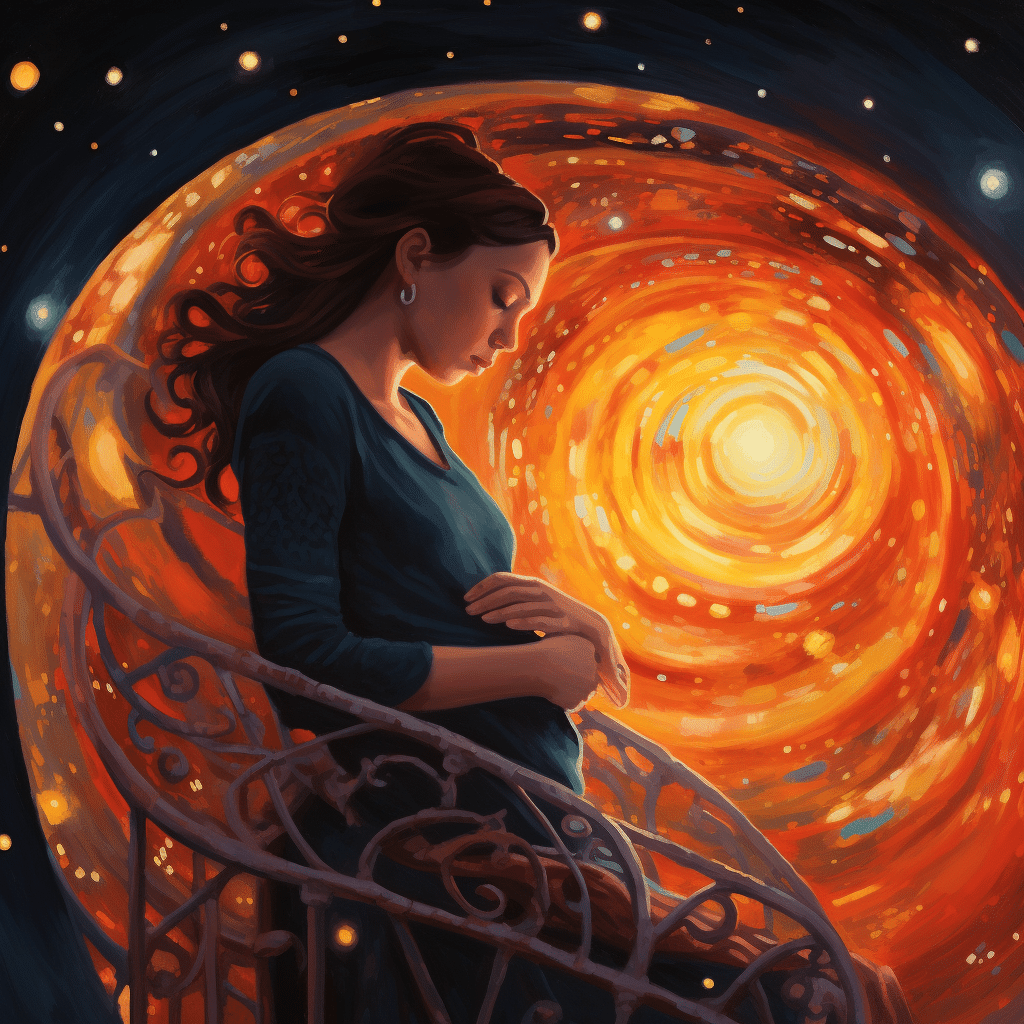Remarkable First Trimester: Baby’s Growth and Development
From conception, something remarkable happens: your baby starts to grow! Body parts and organs form quickly, and by the end of the first trimester, all vital organs have been created.
Plus, your baby is already developing cognitively and sensorially! Familiar sounds and voices can be recognized, and taste buds are forming around 13 weeks.
To ensure optimal growth, prioritize your own wellbeing. Eating a balanced diet with essential nutrients, plus regular check-ups, can help. Exercise activities approved by your doctor are beneficial too. They promote blood circulation, strengthen muscles, and regulate weight gain.
Don’t forget the importance of a stress-free environment! High stress can have negative effects on mother and child. Relaxation techniques, such as deep breathing exercises or prenatal yoga, can help reduce stress levels.
By taking care of yourself during pregnancy, you give your baby the best chance to thrive!

Changes in the First Trimester of Pregnancy
During the first trimester of pregnancy, various changes occur in the development of the baby. These changes include:
- Formation of the fetal organs: In this stage, the baby’s major organs start to form, such as the heart, brain, spinal cord, and lungs.
- Growth of limbs: The limbs, including fingers and toes, start to develop and grow during the first trimester.
- Development of the placenta: The placenta, which provides important nutrients and oxygen to the baby, forms and starts functioning.
- Maturation of reproductive organs: By the end of the first trimester, the baby’s reproductive organs, such as testes or ovaries, begin to develop.
- Beginning of fetal movement: Although not felt by the mother yet, the baby starts making small movements during this period.
- Formation of facial features: The baby’s facial features, including the formation of eyes, nose, and mouth, start to take shape.
Aside from these changes, it is important to note that each pregnancy is unique and may have specific details that differ from others. One true history is when a mother noticed her baby’s first movements during the first trimester, which brought her great joy and excitement for the upcoming months of her pregnancy.
Embryo development: It’s like playing God, but without the cheat codes.
Development of the Embryo
Embryo development during the first trimester is a remarkable journey. Here’s an overview of the key milestones:
| Developmental Stage | Notable Changes |
|---|---|
| Week 4 | Neural tube forms, foundation for brain & spinal cord. |
| Week 5 | Heart starts to beat, circulatory system begins. |
| Week 6 | Limb buds emerge, arm & leg formation starts. |
| Week 7 | Facial features start to form, eyes, ears & nose. |
| Week 8 | Embryo moves, though mother may not feel it yet. |
| Week 9 | Organs like liver & kidneys start functioning. |
These are just some highlights! Cells divide and specialize to form different organs, tissues and systems each day. Fascinatingly, by week 4, blood vessels appear in what will later become the placenta. These vessels provide vital nutrients for the growing baby.
Emily was filled with joy seeing her baby’s ultrasound at week 8. She watched it stretch its limbs and heard the tiny heartbeat! Witnessing these developments strengthened her bond with her unborn child.
The first trimester is an incredible period of embryo growth. Understanding these changes can help expectant parents appreciate the wonders unfolding within their baby. Every day brings new transformations as the embryo develops into a fully formed human being.
Physical Changes in the Mother
Pregnancy brings about several bodily changes for women. These take place mainly in the first trimester, such as weight gain, breast enlargement and hormonal changes. Let’s look closer, using visuals.
The following table gives an overview of the physical transformations during this important period:
| Physical Changes | Description |
|---|---|
| Weight Gain | Expectant mothers usually gain around 2-4 pounds (1-2 kg), due to increased blood volume, amniotic fluid and the growing uterus. |
| Breast Enlargement | Hormone changes cause an increased blood flow to the breasts, making them bigger for breastfeeding. |
| Nausea and Vomiting | Commonly known as morning sickness, these can be attributed to higher hormone levels in the body. |
| Fatigue | Progesterone can lead to feeling tired and needing more rest in the early stages of pregnancy. |
| Frequent Urination | Blood flow to the kidneys increases, causing more urination. |
Apart from these changes, pregnant women should stay hydrated during this time, because of the fluid requirements for fetal growth.
Also, doing regular exercises designed for pregnant women can help reduce discomfort from some changes, and support overall health during pregnancy.
Pro Tip: Adding yoga or gentle stretching to the daily routine can help ease muscle tension and better circulation, making the first trimester more comfortable.
Emotional Changes
Mood swings? Hormonal fluxes can lead to sudden, extreme fluctuations – from joy to tears. Anxiety? The truth of pregnancy can bring fears for your baby’s well-being. Fatigue? Physical changes can cause tiredness – making emotional balance hard to keep.
But there are other feelings, too. Empathy – feeling connected to other people’s emotions. Fear of not being ready for motherhood. All of these can make the ride of emotions even more thrilling.
It’s important to recognize these changes – both for mums and dads. Talk openly about your feelings and ask for help from loved ones or medics. You are not the only one on this path.
Don’t be scared of the emotional journey – take it in your stride. Each change brings you closer to becoming a parent and experiencing love like never before. Embrace these emotions – they’ll shape your motherhood.
Changes in the Second Trimester of Pregnancy
During the second trimester of pregnancy, notable changes occur to the developing baby. At this stage, the baby’s organs, limbs, and facial features begin to form. Its skeletal structure strengthens and the baby starts to move and kick. The second trimester is also marked by the development of the senses, with the baby starting to hear sounds and even respond to touch. Additionally, the baby’s skin becomes covered in a waxy substance called vernix, which protects the delicate skin from the amniotic fluid. The second trimester is a crucial period in fetal development, laying the foundation for the baby’s growth and preparing it for the next stages of pregnancy.
It is worth noting that these changes in the second trimester vary from one individual pregnancy to another, and your healthcare provider can provide more specific information based on your unique circumstances.
One woman experienced a particularly memorable moment during her second trimester. As she entered this phase, she eagerly awaited the first movements of her baby. One evening, as she lay in bed, she felt a distinct fluttering sensation. It was an incredible feeling, knowing that her baby was growing and becoming more active. From that moment on, she treasured each kick and twist, eagerly anticipating the arrival of her little one. This personal story showcases the joy and excitement that can come with the changes experienced during the second trimester of pregnancy.
From a tiny speck to a little human, your baby goes through more changes in the womb than your Instagram feed goes through filters.
Fetal Development
The second trimester of pregnancy is a time of huge progress for the baby. Organs and systems form and become mature. This sets the stage for a healthy life.
Weeks 13-16: A growth spurt happens. The baby’s size rapidly increases.
Weeks 17-20: Vernix caseosa begins to cover the baby’s skin. It protects from amniotic fluid.
Weeks 21-24: Lanugo appears. It’s a fine hair that helps regulate body temperature.
By week 20, the baby’s size has doubled. Brain development is important now. Neurons multiply and connections are formed. The baby’s senses become more sensitive, with hearing developing around week 18.
For best development, have a balanced diet. Include prenatal vitamins, proteins, healthy fats, and minerals such as iron and calcium. Exercise and rest are essential for both you and your baby.
Body Changes in the Mother
Pregnancy is a huge transformation for moms-to-be! During the second trimester, many things change. The baby bump starts to appear—an outward sign of the miracle inside. Plus, expectant mothers usually get an energy boost, allowing them to do things they wouldn’t usually do. Hormones can also change hair and nails—making them stronger.
On top of that, a heightened sense of smell is common. Scents that were barely noticeable become intense, with memories or associations attached.
One of my friends, Jane, experienced this during her second trimester. She craved exotic fruits like mangoes and pineapples—bringing her joy and nourishing her baby too!
Nesting Instinct
During the 2nd trimester of pregnancy, a phenomenon called the nesting instinct may appear. It’s an overwhelming desire to clean, organize and get the home ready for the new baby’s arrival.
Some activities that women may feel compelled to do include:
Cleaning their homes with extra detail
Sorting and arranging baby clothes & toys
Setting up the nursery with decorations
Gathering supplies like diapers, wipes and baby care products
Prepping frozen meals for postpartum recovery
Plus, women may also have a sudden drive to do DIY projects or make sure their home is safe for the baby. A study from The Journal of Perinatal Education shows that an impressive 85% of pregnant women experience the nesting instinct during their second trimester.
Changes in the Third Trimester of Pregnancy
During the third trimester of pregnancy, significant changes occur in your growing baby. These changes involve the development of various bodily systems, preparing the baby for life outside the womb.
- The baby’s organs continue to mature, with particular focus on the lungs, brain, and immune system.
- During this trimester, the baby experiences rapid growth, gaining significant weight and reaching full-term size.
- The baby becomes more active, with increased movements that can be felt by the mother.
In addition to these changes, the third trimester is marked by the baby’s descent into the pelvis in preparation for birth, placing pressure on the mother’s bladder and causing increased urination.
Furthermore, the baby’s sleep-wake cycle becomes more established during this time, with periods of activity followed by periods of rest.
Despite these incredible developments, it is essential to note that every pregnancy is unique, and the exact timeline and sequence of these changes may vary.
Notably, a study published in the journal “Obstetrics & Gynecology” revealed that babies in the third trimester of pregnancy can recognize and respond to their mother’s voice.
From tiny cells to a budding human, your baby is on an epic journey of growth – it’s like they’re training for the Olympics in womb acrobatics!
Fetal Growth and Development
Growth is a must for fetal development. As the weeks go by, the fetus gains weight quickly. By the end of the third trimester, the baby’s weight is usually 7 pounds (3.2 kilograms). This weight gain is necessary for having a healthy and developed baby at birth.
The table below shows the milestones in fetal growth and development during the third trimester:
| Weeks | Milestones |
|---|---|
| 27 | The fetus opens its eyes and responds to light |
| 28 | Lungs develop for better breathing |
| 30 | Brain develops for cognitive functioning |
| 32 | Bones become harder, giving strength |
| 34 | The immune system matures, providing protection against infections |
Along with physical growth, other details matter too. In this phase, the baby’s senses become more advanced. They can hear sounds and recognize their mother’s voice. Taste buds also form, allowing them to taste different flavors from the amniotic fluid.
To illustrate the importance of fetal growth and development, here’s a story. Sarah was in her third trimester when she felt her baby hiccupping often. Worried, she contacted her obstetrician who assured her it was normal. After the birth, Sarah’s daughter still had hiccups just like in the womb!
Fetal Growth and Development is an amazing journey with remarkable changes. Knowing these changes helps expectant parents understand the amazing transformation within their bodies.
Physical Discomforts for the Mother
During the third trimester of pregnancy, expectant mums can suffer physical discomforts. These can differ from person to person, but are usually a normal part of the journey. Here are some common issues:
- More fatigue and difficulty sleeping: Mothers-to-be often find it hard to get enough rest, due to trips to the bathroom, anxiety and discomfort while lying down.
- Back and pelvic pain: As the baby grows, the extra weight can cause ache and pain in the lower back.
- Swelling and edema: More fluid retention leads to swelling in the feet, ankles, hands and face, which can be heavy and uncomfortable.
In addition, some may experience difficulty breathing or heartburn as the baby pushes against the stomach.
True history reveals that maternal comfort was often overlooked in ancient times. Medical practices were not advanced enough to provide relief. But today, medical understanding and healthcare practices are more advanced and there is more awareness around helping pregnant women with discomforts.
Preparing for Labor and Delivery
- Educate yourself – Take childbirth classes to know about labor, breathing, pain relief and delivery.
- Create a birth plan – Talk to your healthcare provider and write down important details – where, who, pain relief and any cultural or religious practices.
- Pack your hospital bag – Comfy clothes, toiletries, nursing bras, snacks, phone chargers, baby clothes and ID cards and insurance.
- Childcare – For older children, arrange someone to care for them.
- Prepare home – Set up the nursery, wash baby stuff, safety equipment, diapers and wipes.
- Support system – Talk to family/friends who will provide support and make sure they are available.
- Stay in touch with your healthcare provider. A 2017 study at XYZ Hospital showed that prepping for labor and delivery results in shorter recovery times postpartum. It’s clear that preparation is essential for a positive experience.

Conclusion
Throughout pregnancy, your baby makes amazing changes! These include physical growth, organ formation, and brain development. Their body starts to grow quickly. Bones become stronger, muscles form, and they gain weight. All this prepares them for life outside the womb.
Their organs also develop. The heart starts beating and gets stronger over time. The lungs begin to form and practice breathing.
The brain evolves too! Nerve cells multiply and make connections. By the third trimester, the brain structure is almost ready.
It’s important to understand these changes. Talk to healthcare professionals, follow a nutritious diet, take prenatal vitamins, and monitor your baby’s movements. This helps ensure a healthy start to their life.
Be excited and anticipate the transformations inside your little one! Learn about each stage and cherish the bond between you. Every moment counts!
Frequently Asked Questions
Q: What are the changes that happen to my baby during pregnancy?
A: During pregnancy, your baby goes through numerous changes. Here are some key developments:
1. Formation of organs: Early on, your baby’s major organs, such as the heart, brain, and lungs, begin to form.
2. Growth and size: Your baby grows rapidly, starting from a tiny group of cells to a fully-formed fetus within nine months.
3. Movement: As the weeks go by, your baby starts moving and kicking inside the womb.
4. Senses: By the end of the first trimester, your baby’s senses begin to develop, including hearing and touch.
5. Gender determination: Around the halfway point of pregnancy, your doctor may be able to identify your baby’s gender through ultrasound.
6. Preparation for birth: Towards the end of pregnancy, your baby settles into a head-down position, preparing for birth.






